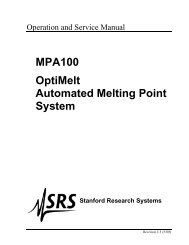Quartz Crystal Microbalance Theory and Calibration - Stanford ...
Quartz Crystal Microbalance Theory and Calibration - Stanford ...
Quartz Crystal Microbalance Theory and Calibration - Stanford ...
Create successful ePaper yourself
Turn your PDF publications into a flip-book with our unique Google optimized e-Paper software.
www.thinkSRS.com<br />
Gas-Phase Measurements<br />
The first use of QCMs was as mass sensors <strong>and</strong> thickness monitors in gas<br />
phase, thin-film depositions. To this date, this continues to be one of the most<br />
important areas of application for this technology.<br />
Sauerbrey Equation<br />
Sauerbrey’s equation (equation 1) is often used to calculate mass loadings <strong>and</strong><br />
thin-film thicknesses in vacuum depositions. The basic assumption is that the<br />
incremental change in mass from the foreign film is treated as though it were<br />
really an extension of the thickness of the underlying quartz, The foreign film is<br />
considered rigid <strong>and</strong> so thin that it does not experience any shear forces during<br />
vibration. As a result, the sensitivity factor, C f , is a fundamental property of the<br />
quartz crystal <strong>and</strong> does not consider any of the properties of the foreign film (i.e.<br />
it is only dependent on the acousto-elastic properties of quartz.)<br />
C f = 2 . n . f o 2 /(ρ q . µ q ) 1/2 (equation 3)<br />
where,<br />
n - number of the harmonic at which the crystal is driven,<br />
f o - the resonant frequency of the fundamental mode of the crystal, in Hz,<br />
ρ q - density of quartz – 2.648 g cm -3 , <strong>and</strong><br />
µ q - shear modulus of quartz - 2.947 . 10 11 g . cm -1. s -2<br />
The dependence of the frequency change on the mass coverage per unit area,<br />
emphasizes the fact that, within certain limits, the sensitivity factor is independent<br />
of the electrode geometry. Thus, in theory, the QCM mass sensor does not<br />
require calibration for this application. This ability to calculate mass loading from<br />
first principles is obviously a very active feature of these devices.<br />
Film thickness is often the parameter of interest in gas-phase thin-film<br />
depositions. If the mass coverage is believed to be uniform, the thickness of the<br />
film is easily calculated dividing the mass per unit area provided by Sauerbrey’s<br />
equation by the material’s density:<br />
T f = ∆m / ρ f (equation 4)<br />
where,<br />
ρ f - density of film material, in g/cm 3 ,<br />
∆m - change in mass per unit area, in g/cm 2<br />
equation), <strong>and</strong><br />
(calculated from Sauerbrey’s<br />
<strong>Stanford</strong> Research Systems (408)744-9040

















